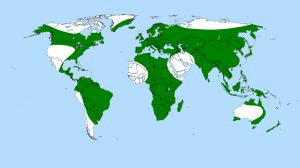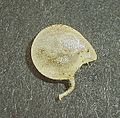Bladderwort facts for kids
Quick facts for kids Bladderwort |
|
|---|---|
 |
|
| Utricularia vulgaris illustration from Jakob Sturm's "Deutschlands Flora in Abbildungen", Stuttgart (1796) | |
| Scientific classification |
|
| Kingdom: | Plantae |
| Clade: | Tracheophytes |
| Clade: | Angiosperms |
| Clade: | Eudicots |
| Clade: | Asterids |
| Order: | Lamiales |
| Family: | Lentibulariaceae |
| Genus: | Utricularia L. |
| Subgenera | |
|
Bivalvaria |
|
| Diversity | |
| 233 species | |
 |
|
| Bladderwort distribution | |
Bladderworts are Utricularia, a genus of carnivorous plants. There are about 230 species. They occur in fresh water and wet soil as terrestrial or aquatic species. They live in every continent except Antarctica. Bladderworts are cultivated for their flowers, which are rather like those of snapdragons and orchids.
All Utricularia are carnivorous and capture small organisms by means of bladder-like traps. Terrestrial species tend to have tiny traps that feed on minute prey such as protozoa and rotifers swimming in water-saturated soil.
The traps range in size from 0.2 mm to 1.2 cm. Aquatic species, such as U. vulgaris (common bladderwort), have bladders that are usually larger and can feed on water fleas (Daphnia), nematodes, even tiny fish, mosquito larvae and young tadpoles.
Despite their small size, the traps are extremely sophisticated. In aquatic species, prey brush against trigger hairs connected to the trapdoor. The bladder, when "set", is under negative pressure: when the trapdoor is triggered, the prey, with the water around it, is sucked into the bladder. Once the bladder is full of water, the door closes again. The whole process takes only ten to fifteen thousandths of a second.
Bladderworts are unusual and highly specialized plants. The bladder traps are recognized as one of the most sophisticated structures in the plant kingdom.
Images for kids
-
The flower stem of the aquatic Utricularia inflata is held aloft by a rosette of floats.
See also
 In Spanish: Utricularia para niños
In Spanish: Utricularia para niños







